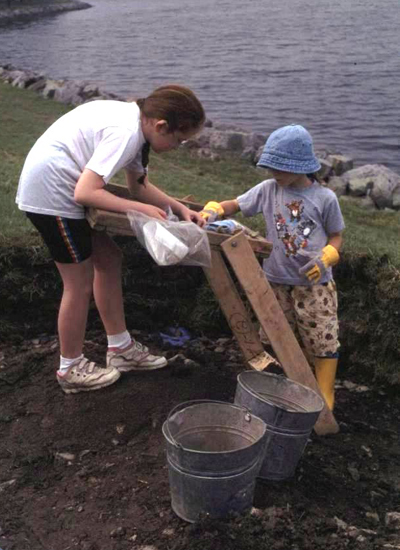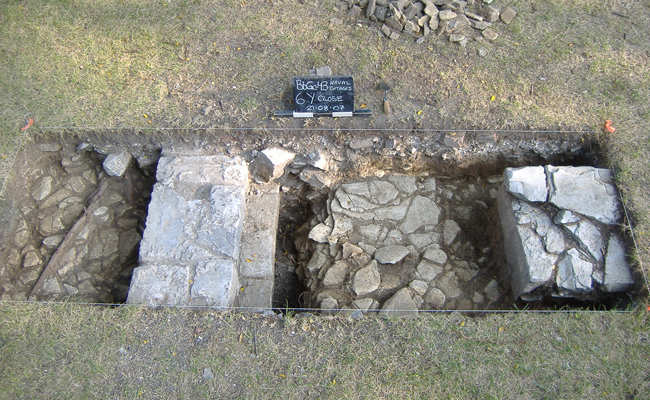The Naval Cottages on Point Frederick were the focus of the Cataraqui Archaeological Research Foundation’s summer archaeology camp “Can You Dig It?”© in 1998, 1999, 2007, 2008, and 2009. The Naval Cottages at the Royal Military College of Canada were located on the western portion of the Point, located on the western shore facing downtown Kingston.

With the outbreak of the War of 1812, a blockhouse was built on Point Henry and the position of the Kingston dockyard was formalized as the British naval base for the Great Lakes fleet. Batteries were hastily constructed on Mississauga Point and Point Frederick which repelled the November American attack. Defenses were strengthened throughout the war, a blockhouse was built on Point Frederick to protect the dockyard and the first Fort Henry was constructed. The dockyard at Kingston became heavily involved in the shipbuilding race which provided the means to end the war.
It is obvious that Kingston was a military or garrison town with soldiers and sailors, but who actually worked at the dockyard and who built the ships? The term artificer was often used on maps and in documents and refers to craftsmen, skilled mechanics and inventors related to the military or navy, they were not, however, soldiers or sailors.
The site of the Naval Cottages at RMC was chosen for the possibility of investigating the site to gather information on military and civilian occupation relating to the Dockyard Period of the first half of the 19th century as well as the development of the Dockyard from the workers' point of view. In addition, archival research indicated that the cottages were constructed in 1822 and a destructive fire terminated occupation in one area in 1868. The 1868 fire destroyed the southerly six cottages and one additional was demolished to create a fire-break. These were completely removed in 1875 when the College was created and the surviving range of nine northerly cottages remained in use until 1910.
The Excavation in the 1998 and 1999 field seasons centred on the two most southern cottages in the row, cottages 15 and 16, both of which were destroyed by fire in 1868. Structural remains were uncovered in 7 excavation units in 1998 and in 7 also in 1999. Four units exposed the southern wall of cottage 16, which is also the most southern wall of the entire Naval Cottages structure. Two of those also revealed a fireplace attached to the southern wall. Two units uncovered the eastern wall of cottage 16 and three others the northern wall, which is also the partitioning wall of cottages 16 and 15. Again, two of these units revealed part of the fireplace attached to the northern wall. In cottage 15, one unit exposed the eastern wall, another the western and one more the corner of the western and northern walls. Three units placed within cottage 15 uncovered the support piers for a staircase/hallway. A large number of artifacts were also uncovered that represent occupation of the cottages from their construction in 1822 to the destruction by fire of the 6 southern cottages in 1868. 
The 2007 and 2008 investigations consisted of six larger units in 2007 and six larger units in 2008, in two sections of the 1822 Naval Cottages. The 2007 season placed units in cottages 1 and at the junction between cottage 1 and 2. The northern most wall of the cottages was located. Units were also excavated in cottages 9 and 10 to examine the impact of the fire-break demolition. In 2008 investigations continued in cottage 10 and into cottage 11 to further examine the transition between the burned and unburned cottages. Three significant finds resulted from these investigations. The location of a section of mortared limestone foundation wall was found and interpreted as being part of the Naval Hospital structure. In 2007, native pottery was found in the northern section of the cottages and indicates that Point Frederick was long in use before the French and British came to the area. Finally, a possible shanty foundation wall was found in 2007, this structure predates the Naval Cottages and is most likely associated with the shanties built and occupied by shipwrights during the war of 1812 period.

In 2009, excavations explored Cottages No.12, 13 and 14 to further investigate the interior and exterior of the cottages that burnt during the fire of 1868. It was also an attempt to determine whether there might be more evidence of the War of 1812 period shanties that pre-dated the construction of the Naval Cottages. Of the six units excavated structural elements were identified in five including the east wall of cottage 13 in 103H and of cottage 14 in 103M, the west wall of cottage 13 in 103K, and interior stair support piers from cottage 13 in 103H and cottage 14 in 103L. No evidence was encountered of War of 1812 period shanty remains, however cultural material similar to that found in other areas of Point Frederick with War of 1812 components was identified on the exterior of cottages 13 and 14. Artifacts consistently date to the period of occupation of the cottages between 1822 and 1868 when this section was destroyed by fire. No later material was encountered with the exception of a few items found in the sod and topsoil.

In light of the pristine nature of the site and the relatively simple stratigraphy present, along with the body of archival research already compiled, the Naval Cottages is an excellent site to teach all aspects of archaeological investigation.





